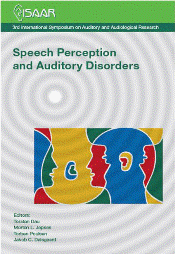The influence of noise type on the preferred setting of a noise reduction algorithm
Abstract
Despite the frequent application of noise reduction in hearing aids, there is little research on user preference for different settings of noise reduction. We therefore measured individual preference for noise reduction strength for speech that was embedded in background noise. In a laboratory experiment, three types of noise (speech shaped stationary noise, party babble, and traffic noise) were processed with two single- channel noise reduction algorithms. Ten normal-hearing and seven hearing-impaired subjects participated. The preference for strength of noise reduction differed between the noise types and this was consistent for the two different noise reduction algorithms. The inter-individual spread between hearing-impaired listeners was as large as between normal-hearing listeners and as a consequence we found no systematic differences between the groups. These results support earlier findings that an individual tuning of noise reduction parameters is important. Furthermore, the results suggest that it could be beneficial to adaptively change the setting of noise reduction in a hearing aid, depending on the type of background noise.
References
Bentler, R., Wu, Y.-H., Kettel, J., and Hurtig, R. (2008). "Digital noise reduction: Outcomes from laboratory and field studies" Int. J. Audiol., 47 (8), 447-460.
Bjerg, A. P., and Larsen, J. N. (2006). Recording of Natural Sounds for Hearing Aid Measurements and Fitting, Ørsted, Denmark: Danish Technical University (DTU), Acoustic Technology.
Brons, I., Houben, R., and Dreschler, W. A. (2011). "Perceptual effects of noise reduction in hearing aids" in ISAAR - International Symposium on Auditory and Audiological Research.
Dreschler, W. A., Verschuure, H., Ludvigsen, C., and Westermann, S. (2001). "ICRA noises: artificial noise signals with speech-like spectral and temporal properties for hearing instrument assessment" International Collegium for Rehabilitative Audiology. Audiology: official organ of the International Society of Audiology, 40 (3), p.148.
Hoetink, A. E., Körössy, L., and Dreschler, W. A. (2009). "Classification of steady state gain reduction produced by amplitude modulation based noise reduction in digital hearing aids" International Journal of Audiology, 48 (7), 444–455.
Houben, R., Dijkstra, T. M. H., and Dreschler, W. A. (2011). "Differences in preference for noise reduction strength between individual listeners" in 130th Convention of the Audio Engineering Society. London, pp. 1-9.
Loizou, P.C., and Kim, G. (2011). "Reasons why current speech-enhancement algorithms do not improve speech intelligibility and suggested solutions" IEEE Transactions on Audio, Speech, and Language Processing, 19 (1), 47– 56.
Luts, H., Eneman, K., Wouters, J., Schulte, M., Vormann, M., et al. (2010). "Multicenter evaluation of signal enhancement algorithms for hearing aids" J. Acoust. Soc. Am., 127 (3), 1491-1505.
Versfeld, N. J., Daalder, L., Festen, J. M., and Houtgast, T. (2000). "Method for the selection of sentence materials for efficient measurement of the speech reception threshold" J. Acoust. Soc. Am., 107(3), 1671-1684.
Wickelmaier, F., and Choisel, S., (2006). "Modeling within-pair order effects in paired-comparison judgments" in 22nd Annual Meeting of the International Society for Psychophysics. St. Albans, Hertfordshire, England, pp. 89–94.
Zhao, D. Y., Kleijn, W. B., Ypma, A., and de Vries, B., (2008). "Online Noise Estimation Using Stochastic-Gain HMM for Speech Enhancement" IEEE Transactions on Audio Speech and Language Processing, 16(4), p.835.
Additional Files
Published
How to Cite
Issue
Section
License
Authors who publish with this journal agree to the following terms:
a. Authors retain copyright* and grant the journal right of first publication with the work simultaneously licensed under a Creative Commons Attribution License that allows others to share the work with an acknowledgement of the work's authorship and initial publication in this journal.
b. Authors are able to enter into separate, additional contractual arrangements for the non-exclusive distribution of the journal's published version of the work (e.g., post it to an institutional repository or publish it in a book), with an acknowledgement of its initial publication in this journal.
c. Authors are permitted and encouraged to post their work online (e.g., in institutional repositories or on their website) prior to and during the submission process, as it can lead to productive exchanges, as well as earlier and greater citation of published work (See The Effect of Open Access).
*From the 2017 issue onward. The Danavox Jubilee Foundation owns the copyright of all articles published in the 1969-2015 issues. However, authors are still allowed to share the work with an acknowledgement of the work's authorship and initial publication in this journal.


